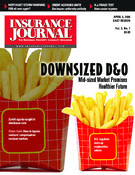Publicly traded property casualty insurance companies must serve many masters. To be competitive in the marketplace, they must offer products that meet the needs of consumers, at prices that are competitive with the expectations of agents as well as the budgets of consumers–personal and commercial.
Insurers must prepare financial statements in accordance with the requirements of the National Association of Insurance Commissioners (NAIC) and then present the Securities and Exchange Commission with financial statements that are consistent with generally accepted accounting principles. To receive high ratings, they must understand, address and meet the requirements of rating agencies. In addition to all of this, they must attract and retain investors. This last requirement demands that the publicly traded insurer’s earnings meet or exceed Wall Street expectations.
We should not underestimate the impact of Wall Street’s earning expectations or rating agency earnings expectations on insurance companies. Immediately subsequent to catastrophes, such as the activity that occurred in the southeastern United States in the fall of 2005, publicly traded insurance companies issue press releases that provide estimates of the anticipated impact of the event on after-tax net income. Sometimes, the after-tax impact on earnings is estimated and expressed in cents per share.
Meeting Wall Street’s expectations
Since each dollar of loss and loss adjustment expense reserves (L&LAE) impacts pre-tax income by a dollar, one way to meet Wall Street earnings expectations might be to manage the Company’s L&LAE reserves. For example, if current L&LAE reserves are redundant (meaning that current and future losses can be settled for less than the current estimate booked by the Company), and the current quarter’s earnings estimate can be met with L&LAE reserves at the current level, management may decide to defer the release of all or part of the redundancy. The release of redundancy, to lower loss reserves, and thereby generate additional income to meet or exceed the earnings expectations of analysts, can be deferred to another reporting period.
Clearly, when reserves are redundant, the hypothetical situation outlined above works to the benefit of the primary parties involved in the insurance transaction–meritorious claimants, corporate management, rating agencies, Wall Street analysts and investors. However, how should we view a publicly traded company that meets the earnings expectations of rating agencies and Wall Street analysts but, by its own calculations, does so by underestimating its L&LAE reserves? In other words, when the Company has determined that its loss reserves were understated, and therefore, the pre-tax income that they reported was overstated, should this Company still be considered to have met its (historical) earnings target?
Trust in reliable rating
Most users of insurance company ratings would hope (believe?) that rating agencies and their analysts would be on the lookout for loss reserving shenanigans. Now and again, an insurer that has traditionally been properly reserved maybe tolerated to be under-reserved on occasion. However, if the under-reserving is chronic or of a significant dollar amount, we would expect the under-reserved P/C insurance company to have its rating revised downward because they did not actually meet their earning expectations. In fact, when a company reported earnings, in whole or in part, based upon a low level of L&LAE reserves, we might expect future reports of earnings to be taken with a grain of salt.
Unfortunately for those who rely on better-known rating agencies to assess whether or not publicly traded P/C insurance companies book realistic loss and loss adjustment expense reserves, and thereby report earnings that withstand the test of time, high ratings can be and are assigned to companies that have under-estimated their loss and loss adjustment expense reserves.
We recently reviewed the historical L&LAE reserve adequacy of 14 publicly traded P/C insurance companies that were part of a database of 2,698 P/C insurers. Their market share for calendar year 2004 was approximately 10 percent of the premium volume of the entire group.
Each of these 14 insurers reported adverse one-year development greater than their reported income for the previous year. This means their income was based upon under-estimating their losses. In addition, each of these companies reported two-year adverse development greater than their reported income of two years earlier. Once again, this implied their reported income was the result of under-estimating of losses.
A summary of the financial position of these 14 publicly traded P&C insurance companies follows: They represented about one-half of 1 percent of the 2,698 companies under review. They reported about 10 percent of the net writings of the 2,698 companies. Unfortunately, they reported 52 percent of the one-year development of the same group of companies under review. In addition, they accounted for 38 percent of the two-year development of the group. Their adverse loss development, based upon what they reported as two-year adverse development, was eight times their reported income in 2004!
The ratings assigned to this group by the major rating services were at the higher end of their range of ratings. Each of these 14 P/C companies continue to be acceptable based upon the traditional rating criteria utilized by consumers and businesses.
Evidently, when the Wall Street mandate to hit earning estimates conflicts with Schedule P Interrogatory 7.1, namely, the information provided in Schedule P will be used by many persons to estimate the adequacy of the current loss and expense reserves; Wall Street is victorious.
Users beware
This analysis should be a warning to those who outsource their financial due diligence of insurance companies to a single rating agency. High ratings do not equate to adequate loss and loss adjustment expense reserves. In fact, the overwhelming majority of the property casualty industry’s adverse loss and LAE reserve development is attributable to companies with high ratings.
To address the needs of consumers and businesses that are interested in insurance markets with adequate loss and loss adjustment expense reserves, in 2006, Demotech, Inc. will publish descriptive rating information focused on balance sheet fundamentals. We believe that the insurance needs of Main Street cannot be addressed when carriers and rating services think like Wall Street.
Joseph L. Petrelli is president and founder of Demotech Inc., a Columbus, Ohio-based financial analysis and actuarial services firm. Petrelli is a member of the Casualty Actuarial Society, American Academy of Actuaries and the Conference of Actuaries in Public Practice. For more information visit: www.demotech.com.
Was this article valuable?
Here are more articles you may enjoy.


 Iowa Woman Charged With Insurance Fraud
Iowa Woman Charged With Insurance Fraud  10 Highest Class-Action Settlements in 2025 Eclipsed $70B Total: Duane Morris
10 Highest Class-Action Settlements in 2025 Eclipsed $70B Total: Duane Morris  Court Orders Justice Family Coal Companies to Pay $1M to Liberty Mutual Unit
Court Orders Justice Family Coal Companies to Pay $1M to Liberty Mutual Unit  Update: Verizon Says Service Restored After Thousands Affected by Outage
Update: Verizon Says Service Restored After Thousands Affected by Outage 



